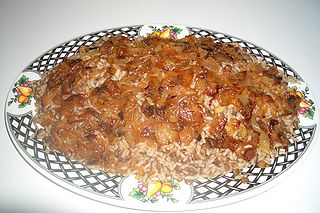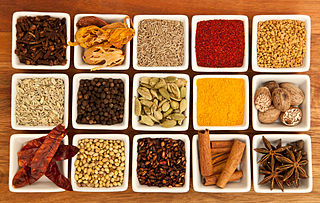Related Research Articles
Kitniyot is a Hebrew word meaning legumes. During the Passover holiday, however, the word kitniyot takes on a broader meaning to include grains and seeds such as rice, corn, sunflower seeds, and sesame seeds, in addition to legumes such as beans, peas, and lentils.

Jewish cuisine refers to the worldwide cooking traditions of the Jewish people. During its evolution over the course of many centuries, it has been shaped by Jewish dietary laws (kashrut), Jewish festivals and holidays, and traditions centred around Shabbat. Jewish cuisine is influenced by the economics, agriculture, and culinary traditions of the many countries where Jewish communities have settled and varies widely throughout the entire world.

Cholent and other Sabbath stews are traditional Jewish stews. It is usually simmered overnight for 10–12 hours or more, and eaten for lunch on Shabbat. Shabbat stews were developed over the centuries to conform with Jewish laws that prohibit cooking on the Sabbath. The pot is brought to a boil on Friday before the Sabbath begins, and sometimes kept on a blech or hotplate, or left in a slow oven or electric slow cooker, until the following day. Cholent originated as a barley porridge in ancient Judea called "harisa" or "horisa", possibly as far back as the Second Temple period, and over the centuries various Jewish diaspora communities created their own variations of the dish based on local food resources and neighborhood influence.
In Judaism, Nusach, plural nuschaot or Modern Hebrew nusachim, refers to the exact text of a prayer service; sometimes the English word "rite" is used to refer to the same thing. Texts used by different communities include Nosach Teiman, Nusach Ashkenaz, Nusach Sefard, Nusach Edot Hamizrach, and Nusach Ari. In English, the word nusach means formulate, wording.

Mujaddara consists of cooked lentils together with groats, generally rice, and garnished with sautéed onions.

Indian breads are a wide variety of flatbreads and crêpes which are an integral part of Indian cuisine. Their variation reflects the diversity of Indian culture and food habits.
Pizmonim are traditional Jewish songs and melodies sung with the intention of praising God as well as learning certain aspects of traditional religious teachings. They are sung throughout religious rituals and festivities such as prayers, circumcisions, bar mitzvahs, weddings and other ceremonies.

Syrian Jews are Jews who lived in the region of the modern state of Syria, and their descendants born outside Syria. Syrian Jews derive their origin from two groups: from the Jews who inhabited the region of today's Syria from ancient times ; and from the Sephardi Jews who fled to Syria after the Alhambra Decree forced the expulsion of the Jews from Spain in 1492.

Sephardic Jewish cuisine is an assortment of cooking traditions that developed among the Sephardi Jews.

Since the 10th century BCE, Jerusalem has been the holiest city, focus and spiritual center of the Jews. Jerusalem has long been embedded into Jewish religious consciousness and Jews have always studied and personalized the struggle by King David to capture Jerusalem and his desire to build the Holy Temple there, as described in the Book of Samuel and the Book of Psalms. Many of King David's yearnings about Jerusalem have been adapted into popular prayers and songs. Jews believe that in the future the rebuilt Temple in Jerusalem will become the center of worship and instruction for all mankind and consequently Jerusalem will become the spiritual center of the world.
This article describes the principal types of religious Jewish music from the days of the Temple to modern times.

Israeli cuisine comprises both local dishes and dishes brought to Israel by Jews from the Diaspora. Since before the establishment of the State of Israel in 1948, and particularly since the late 1970s, an Israeli Jewish fusion cuisine has developed.

Mizrahi Jewish cuisine is an assortment of cooking traditions that developed among the Jews of the Middle East, North Africa, Asia, and Arab countries. Mizrahi Jews have also been known as Oriental Jews.
Keftes, also known as Keftikes in Sephardic cuisine, are croquettes, pancakes, patties, or fritters, usually made with vegetables, and other ingredients. Sephardic keftes are not the same as the non-Jewish kofta which are meatballs. Keftes might not contain meat, as opposed to the kofta which do contain meat.
Ancient Israelite cuisine refers to the culinary practices of the Israelites from the Late Bronze Age arrival of Israelites in the Land of Israel through to the mass expulsion of Jews from Roman Judea in the 2nd century CE. Dietary staples among the Israelites were bread, wine, and olive oil; also included were legumes, fruits and vegetables, dairy products, fish, and meat.

Malaysian Indian cuisine, or the cooking of the ethnic Indian communities in Malaysia, consists of adaptations of authentic dishes from India, as well as original creations inspired by the diverse food culture of Malaysia. Because the vast majority of Malaysia's Indian community are of South Indian descent, and are mostly ethnic Tamils who are descendants of immigrants from a historical region which consists of the modern Indian state of Tamil Nadu and Sri Lanka's Northern Province, much of Malaysian Indian cuisine is predominantly South Indian inspired in character and taste. A typical Malaysian Indian dish is likely to be redolent with curry leaves, whole and powdered spice, and contains fresh coconut in various forms. Ghee is still widely used for cooking, although vegetable oils and refined palm oils are now commonplace in home kitchens. Before a meal it is customary to wash hands as cutlery is often not used while eating, with the exception of a serving spoon for each respective dish.
Macaroni Hamin is a traditional Sephardic Jerusalemite dish originally from the Jewish Quarter of the Old City of Jerusalem. It consists of macaroni, chicken, potatoes and spices. Traditionally Macaroni Hamin is slow cooked overnight before Shabbat. Similar to other dishes prepared in communities of Jewish Sephardic and Iraqi origin haminados eggs can be added. Macaroni Hamin is still eaten by Sephardic Jews who have origins inside the Old City of Jerusalem.
Shabbat meals or Shabbos meals are the three meals eaten by Shabbat-observant Jews, the first on Friday night, the second on Saturday day, and the third late on Saturday afternoon. The Hebrew word for meal is seudah, with the plural version being seudos or seudot, thus the Friday night and Saturday day meals are often called seudot or seudos. The third meal, held on Saturday afternoon is called either shalosh seudos, seudah shlishit, or shaleshudus.
Lokshen, also known as Itriyot, locshen, lockshen, or Jewish egg noodles, is the common name of a range of Ashkenazi Jewish egg noodles that are commonly used in a variety of Jewish dishes including chicken soup, kugel, kasha varnishkes, lokshen mit kaese, and as a side dish to Jewish brisket, sweet and sour meat balls, apricot chicken, and many other dishes. They may also be served with melted butter or a simple tomato sauce. In the United States, lokshen are also used as the basis for various casseroles and baked dishes including tuna noodle casserole, and both sweet and savory lokshen kugels.
References
- ↑ "FEATURE-Biblical cuisine inspires Bible learning in Israel". TheMarker. Retrieved 23 October 2019.
- ↑ "Jerusalem Talmud" . Retrieved 30 July 2021.